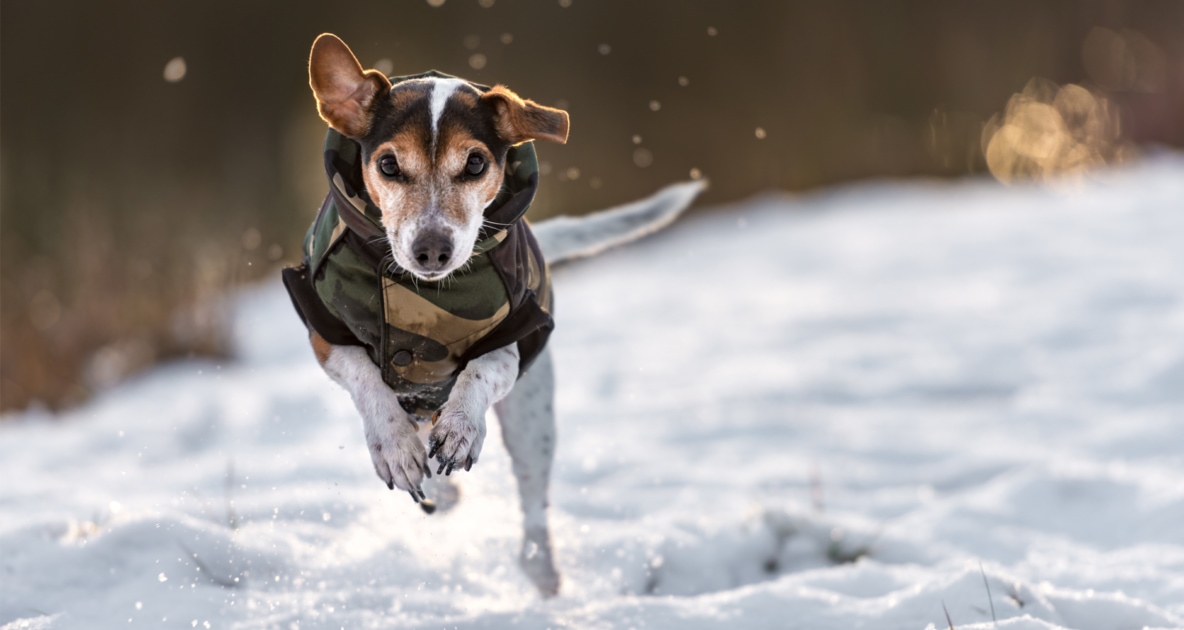Protect Your Pets in Winter With These Important Tips
Freezing weather can be dangerous for your pets. Learn how to protect them during times of extremes.

Each year, thousands of pets left out in the cold suffer painful effects of frostbite or hypothermia, or even freeze to death. In freezing and sub-freezing conditions, often exacerbated by rain or snow, experts say it is a myth that dogs and cats can fend for themselves any more than human beings can. In winter, a little common sense and compassion on the part of pet owners goes a long way.
Some Breeds Handle The Cold Better Than Others, But…
While certain hardy breeds with long, thick coats, such as adult Malamutes and German Shepherds, may fair better in the cold, most breeds cannot adapt to the elements and need sweaters for insulation and limited exposure time. The skin on your pet—particularly his ears, nose, foot pads, tail, and any exposed areas such as the belly—can freeze in as few as 20 minutes in sub-zero temperatures. If it’s too cold for you to be outside, it’s too cold for most domestic animals. No matter what the breed, puppies, senior animals, those with arthritis or other frailties should never be out longer than necessary in winter, per the American Veterinary Association (AVA). According to the SPCA, in cold weather a car’s interior acts like a refrigerator or freezer, so leaving an animal in a vehicle is definitely not recommended.
Signs of Exposure in Animals:
- Fur stands erect (like goose bumps in humans), signaling decreased body temperature;
- Shivering is triggered to generate heat;
- Shivering becomes violent and animal becomes listless and uncoordinated, with hypothermia probable at this point;
- Collapse and coma ensue, with major organs shutting down;
- If frostbite is present, tissues are bright red, followed by pale color and then black (indicating death of tissue).
What to do:
- Immediately seek veterinary help and use 24-hour emergency facilities if after hours; wrap animal in coat or blankets.
- If veterinary care is not available and the animal is wet, immerse in lukewarm (not warm or hot) bath, gradually increasing temperature of water.
- Rub vigorously with towels for circulation.
- Apply warm packs such as hot water bottles to animal’s arms if they have less fur, also to chest and abdomen.
- Warming with a hairdryer on medium heat can also help (wrap animal in blankets as soon as possible), as can a heating pad wrapped in towels (do not expose directly to animal’s skin).
8 Important Winter Pet Safety Tips
According to the ASPCA, these steps are recommended for your pet’s safety in winter:
- Keep your pet leashed on walks. More pets become lost in the winter than any other season because snowfall can disguise recognizable scents that would normally help him find his way home. Make sure his collar has up-to-date contact information or get him microchipped.
- Grab A Coat. Not all dogs need a coat in winter but smaller breeds or short-haired breeds can benefit from an extra layer of warmth.
- Clear the snow and ice. After a walk or exposure to snow and ice, it’s important to clear away the ice balls that may collect between your pet’s toes and cause painful freezing or frostbite. Toxic ice melting products like rock salt may also collect in paws and rinsing and wiping well will prevent ingestion of chemicals that can cause irritation, vomiting and diarrhea when licked. Use pet-friendly ice melts whenever possible.
- Be sure your emergency kit includes pet items. Winter power outages are a common occurrence. Make sure your emergency kit contains enough food, water, and medication to last your pets for at least five days.
- Check the hood. In the winter, cats often sleep under the hood and in the wheel wells of cars during the winter months to keep warm. Prevent injuries by banging loudly on your hood or honking the horn before starting your car.
- Stay away from ice. When walking your dog, be sure to avoid frozen lakes and ponds. These areas often look safe but we’ve all seen it too often — the ice gives way. Your dog could be seriously hurt or even killed if the ice breaks.
- Bathe your pets as little as possible during cold spells. Washing too often can remove essential oils and increase the chance of developing dry, flaky skin.
- Protect those paw pads! Massaging petroleum jelly or protectants onto your dog’s paw pads before going outside can help protect him from salt and chemical agents. Booties provide even more protection and can also prevent sand and salt from getting lodged between bare toes.
Beth Herman
Beth Herman is a freelance writer with interests in healthy living and food, family, animal welfare, architecture and design, religion, and yoga. She writes for a variety of national and regional publications, institutions, and websites.






Thank you
what about the cats, kittens and mature..? I bought animal heating pads to put in safe and secure housing enclosed inside another building but at below zero temps, I want them in the house if they’ll come in. They are outdoor/indoor cats.
Where can you find Musher’s Secret?
Thanks for an answer.
A great product for dog paws is Musher’s Secret. It’s used for sled dogs.
I got some this winter. Keeps the dogs paws from cracking, collecting ice balls, and forms a thin barrier to protect their paws from snow, ice and salt.
You can use it in the summer for walks on hot pavement too.
Every winter in So. Texas brings us surprises. This winter was no different. Our furry friend sleeps inside on their own bed. I remember every winter of a friend that had an “outdoor” pet that they “allowed” to sleep inside their closed garage. They thought they did their tiny pet a good turn by adding a piece of cardboard on the garage floor. Sadly the next morning after they had slept soundly inside, they found their frozen friend. I hope they never forget that moment…………I know I won’t forget to help my furry friend as she helps me daily.
Thanks for this article on pets. Eventhough, we live in a warmer part of Texas, we still do take precautions for our pets outside. We found that our south porch is mostly warm if we cover the east and west sides plus some light bulbs turned on during this time, plus crates, carpets, where they an huddle together is good for us. This past month as you know we have had pretty bad cold weather here in South Texas so for us that we do not really use our coats, this was bad. Today we are enjoying our 😯 ‘s weather, Thanks to God.